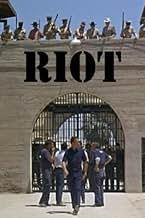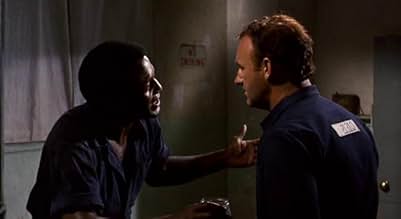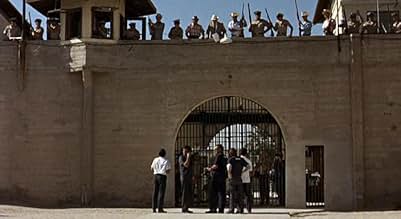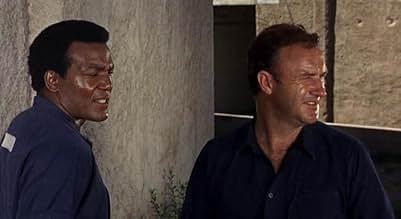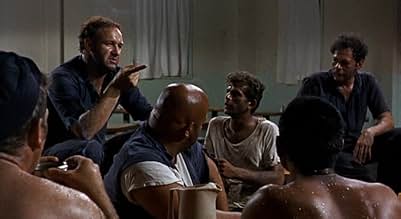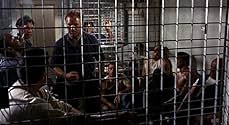Ajouter une intrigue dans votre langueA riot in a state prison is staged to cover up an escape attempt, during which many inmates and guards are killed. Shot on location at Arizona State Prison.A riot in a state prison is staged to cover up an escape attempt, during which many inmates and guards are killed. Shot on location at Arizona State Prison.A riot in a state prison is staged to cover up an escape attempt, during which many inmates and guards are killed. Shot on location at Arizona State Prison.
Avis à la une
"Riot" is a very tense film that was apparently based on a book about an actual prison situation that occurred in Minnesota. Oddly, however, "Riot" was filmed in Arizona--about the most un-Minnesota like place you can find! It's also unusual in that the famed horror director, William Castle, produced it.
The film stars Jim Brown and Gene Hackman, but they are not the entire show. In fact, while they clearly are the leads, the real stars are the many prisoners--many of which really were prisoners of the Yuma Correctional facility. It gets very high marks for realism that is missing from most other prison films and must have been seen as a VERY gritty film when it debuted. Flamboyantly gay prisoners, home brewed alcohol, impromptu courts to dispense 'justice' to snitches and a lot of blood are things you really don't see in other more sanitized prison films. Because of that, I highly recommend the film--it's tough, tense and exciting throughout.
The film stars Jim Brown and Gene Hackman, but they are not the entire show. In fact, while they clearly are the leads, the real stars are the many prisoners--many of which really were prisoners of the Yuma Correctional facility. It gets very high marks for realism that is missing from most other prison films and must have been seen as a VERY gritty film when it debuted. Flamboyantly gay prisoners, home brewed alcohol, impromptu courts to dispense 'justice' to snitches and a lot of blood are things you really don't see in other more sanitized prison films. Because of that, I highly recommend the film--it's tough, tense and exciting throughout.
I realized in time for his centenary tribute that this tense jailbreak thriller was produced by William Castle; the film does not have much of a reputation, however, and is perhaps most notable for being one of a number of transitory parts for Gene Hackman between his acquiring fame in BONNIE AND CLYDE (1967) and stardom via THE FRENCH CONNECTION (1971) – another such effort, THE SPLIT (1968), had partnered him with Jim Brown (who also assumes the leading role here). Indeed, Hackman's superiority in the acting stakes – despite essentially playing second- fiddle to ex-American Football luminary Brown – in comparison to the other participants (more on this later) is palpable throughout. Having said that, Gerald S. O'Loughlin is initially set out as the prisoners' chief nemesis but his contribution gradually diminishes once the titular event takes centre-stage.
The movie is basically an updated and more brutal version of earlier prison dramas, the obvious prototype being Don Siegel's noir classic RIOT IN CELL BLOCK 11 (1954). What is interesting in this case is that the riot is borne out of an attempted mass escape of the isolation division; when the latter is foiled, mastermind Hackman decides to buy some time – ostensibly negotiating system reforms with the authorities on the outside (as it happens, the fearsome warden has chosen this precise moment to take a break!) – while a tunnel is being laboriously dug from under the auditorium to freedom just past the walls of the vast compound!! Incidentally, Castle is to be commended for shooting this in an authentic Arizona correctional facility – with not only the real-life warden filling his respective shoes within the narrative (I wonder whether he was aware of how unsympathetically his office was being depicted!) but also a number of the convicts themselves!!
As I said, the film features a number of contemporary trappings which, frankly, do it (and even more so the genre involved) no more than a disservice – notably a substance-fuelled party by the inmates, with a handful of them in drag so as to titillate their 'colleagues'; one of them even invites coloured macho Brown to his cell, but he obviously backs off (preferring to envision a clutch of bikini-clad 'sisters' in the movie's one scene with female presences, drooling over him)! Similarly over-the-top are the actions of a wacky knife-happy Indian who constantly antagonizes Brown, and whom Hackman needs tagging along in order to supply guidance in their eventual flight to Mexico only to have his throat memorably slit by him at their very moment of glory (many of the intended fugitives had already been routed by the shrewd warden)! Among the assets, then, are the pristine DVD-sourced look and Krzysztof Komeda's unusual score (albeit backed by a recurring wistful ballad that acts as Brown's theme tune), the esteemed Polish composer's last effort prior to his untimely tragic death – and which ties the picture with Castle's much more distinguished production ROSEMARY'S BABY (1968).
The movie is basically an updated and more brutal version of earlier prison dramas, the obvious prototype being Don Siegel's noir classic RIOT IN CELL BLOCK 11 (1954). What is interesting in this case is that the riot is borne out of an attempted mass escape of the isolation division; when the latter is foiled, mastermind Hackman decides to buy some time – ostensibly negotiating system reforms with the authorities on the outside (as it happens, the fearsome warden has chosen this precise moment to take a break!) – while a tunnel is being laboriously dug from under the auditorium to freedom just past the walls of the vast compound!! Incidentally, Castle is to be commended for shooting this in an authentic Arizona correctional facility – with not only the real-life warden filling his respective shoes within the narrative (I wonder whether he was aware of how unsympathetically his office was being depicted!) but also a number of the convicts themselves!!
As I said, the film features a number of contemporary trappings which, frankly, do it (and even more so the genre involved) no more than a disservice – notably a substance-fuelled party by the inmates, with a handful of them in drag so as to titillate their 'colleagues'; one of them even invites coloured macho Brown to his cell, but he obviously backs off (preferring to envision a clutch of bikini-clad 'sisters' in the movie's one scene with female presences, drooling over him)! Similarly over-the-top are the actions of a wacky knife-happy Indian who constantly antagonizes Brown, and whom Hackman needs tagging along in order to supply guidance in their eventual flight to Mexico only to have his throat memorably slit by him at their very moment of glory (many of the intended fugitives had already been routed by the shrewd warden)! Among the assets, then, are the pristine DVD-sourced look and Krzysztof Komeda's unusual score (albeit backed by a recurring wistful ballad that acts as Brown's theme tune), the esteemed Polish composer's last effort prior to his untimely tragic death – and which ties the picture with Castle's much more distinguished production ROSEMARY'S BABY (1968).
RIOT is a 1969 shoestring B production that looks like a made for TV time-passer with Jim Brown at the top of his game, and Gene Hackman, fresh from his small but eye-catching part in BONNIE AND CLYDE (1967) on his way up, with stardom assured two years later as copper Popeye Doyle in FRENCH CONNECTION. The two men had already appeared together in THE SPLIT (1968)
Substandard photography does not hurt the film, rather adding to its credibility as a tale about a breakout from a dingy jail with inhuman guards. Good singing from Bill Medley - great voice - as part of somewhat uneven score. Generally effective dialogue ahead of its time by including gay prisoners, shocking ending.
Competent direction from William Castle, who made his name in horror movies but does a competent job with RIOT. 7/10.
Substandard photography does not hurt the film, rather adding to its credibility as a tale about a breakout from a dingy jail with inhuman guards. Good singing from Bill Medley - great voice - as part of somewhat uneven score. Generally effective dialogue ahead of its time by including gay prisoners, shocking ending.
Competent direction from William Castle, who made his name in horror movies but does a competent job with RIOT. 7/10.
Small budget movie,which Gene Hackman's fans might want to see.Its main originality lies in the fact that it does not show life in prison,but the inmates' revenge ,after a few wardens have been held hostages .The prisoners try to fool the prison authorities as they write a petition in order to improve their living conditions in jail while digging a tunnel .But it's many a mile to freedom .Not as good as Siegel's "escape from Alcatraz" (both movies are reportedly true stories).Very violent ,mainly in the second half.
Note:the movie was produced by William Castle with a score by Christopher Komeda.This team worked on "Rosemary's baby" the year before.And "Riot" music resembles that of "Rosemary".Notably,the sequence when the men are walking through the tunnel uses almost the same music as the sequence when Rosemary ,with a knife in her hand,walks through the corridor that leads to the Castevet's apartment.
Note:the movie was produced by William Castle with a score by Christopher Komeda.This team worked on "Rosemary's baby" the year before.And "Riot" music resembles that of "Rosemary".Notably,the sequence when the men are walking through the tunnel uses almost the same music as the sequence when Rosemary ,with a knife in her hand,walks through the corridor that leads to the Castevet's apartment.
Cool song "100 Years" sung by Bill Medley, music by Christopher Komeda. Shot on location at Arizona State Prison. Great performances by Jim Brown and Gene Hackman. A cool moment is the dream Cully Briston (Jim Brown) has when he takes a nap in the cell. The last 15 minutes of the film are also the best, the ones full of suspense. The rest of the movie is tense boredom.
Le saviez-vous
- AnecdotesArizona State Penitentiary warden Frank Eyman and 600 inmates and prison staff appear in the movie.
- Versions alternativesAn edited, "PG" rated version was released to theaters in 1970. Video version is the complete "R" rated version.
- ConnexionsReferenced in Summer in the City (1971)
- Bandes originalesRAG MOP
Words and Music by Johnny Lee Wills and Deacon Anderson
Meilleurs choix
Connectez-vous pour évaluer et suivre la liste de favoris afin de recevoir des recommandations personnalisées
- How long is Riot?Alimenté par Alexa
Détails
- Durée1 heure 36 minutes
- Mixage
- Rapport de forme
- 1.85 : 1
Contribuer à cette page
Suggérer une modification ou ajouter du contenu manquant

Lacune principale
By what name was La mutinerie (1969) officially released in India in English?
Répondre
